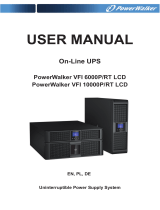
Safety of persons
Terminal blocks may be energized even if the system is disconnected from the
AC power source.
Dangerous voltage levels are present within the system. It should be opened
exclusively by qualified service personnel.
The system must be properly grounded, always connect the earth wire first.
Product safety
The PDU connection instructions and operation described in the manual must
be followed in the indicated order.
CAUTION - To reduce the risk of fire, the unit connects only to a circuit
provided with branch circuit overcurrent protection for :
63A rating, for 6kVA models,
100A rating, for 10kVA models
The upstream circuit breaker for Normal AC/Bypass AC must be easily
accessible. The unit can be disconnected from AC power source by opening this
circuit breaker.
Disconnection and overcurrent protection devices shall be provided by others
for permanently connected AC input (Normal AC/Bypass AC) and AC output
circuits.
Check that the indications on the rating label correspond with your AC
powered system and the actual electrical consumption of all the equipment to
be connected to the system.
For PLUGGABLE EQUIPMENT, the socket-outlet shall be installed near the
equipment and shall be easily accessible
Never install the system near liquids or in an excessively damp environment.
Never let a foreign body penetrate inside the system.
Never block the ventilation grates of the system.
Never expose the system to direct sunlight or source of heat.
If the system must be stored prior to installation, storage must be in a dry
place.
The admissible storage temperature range is -25°C to +60°C.
Special precautions
This PDU is designed to work with UPS.
All repairs and service should be performed by AUTHORIZED SERVICE
PERSONNEL ONLY. There are NO USER SERVICEABLE PARTS inside the PDU.

















